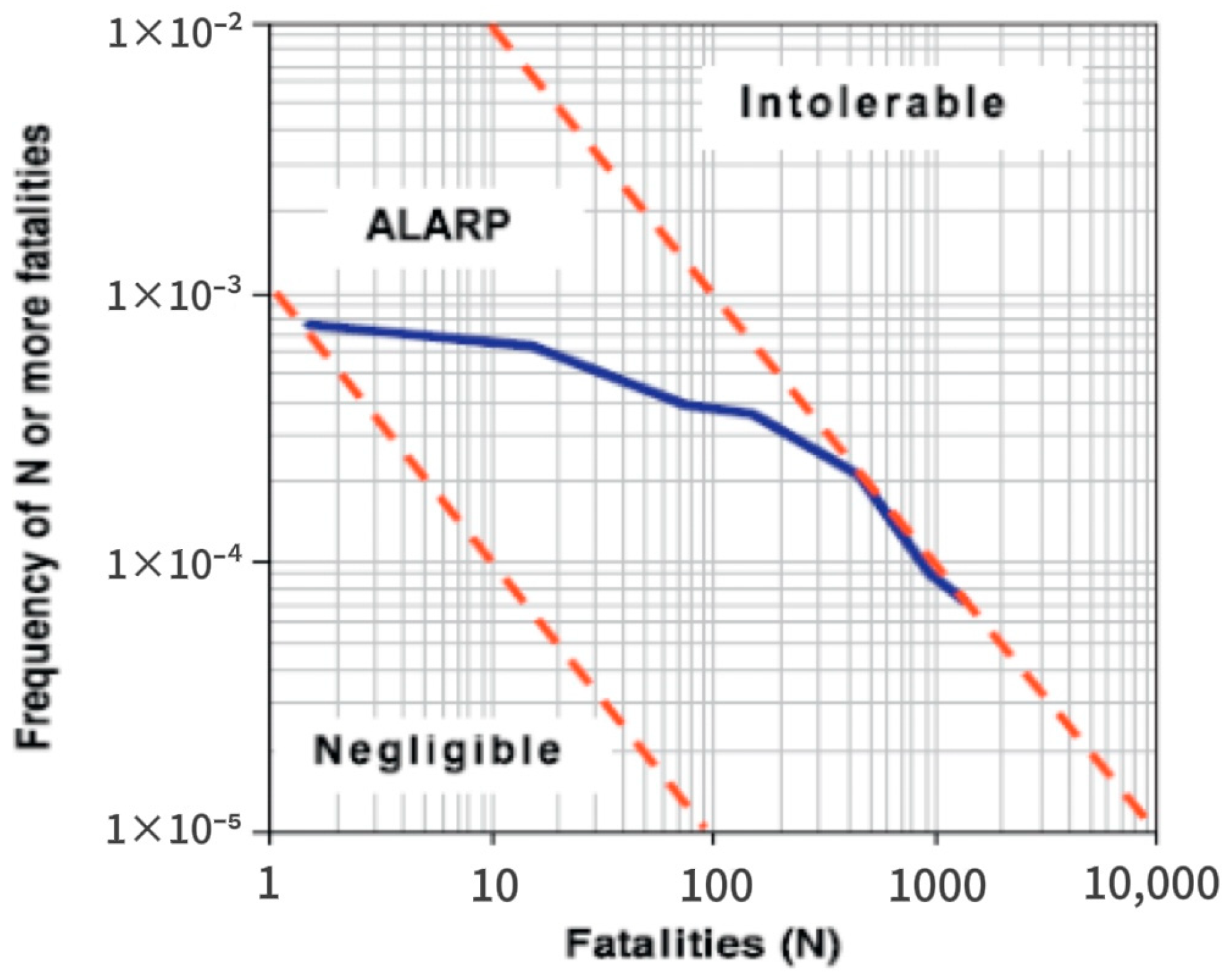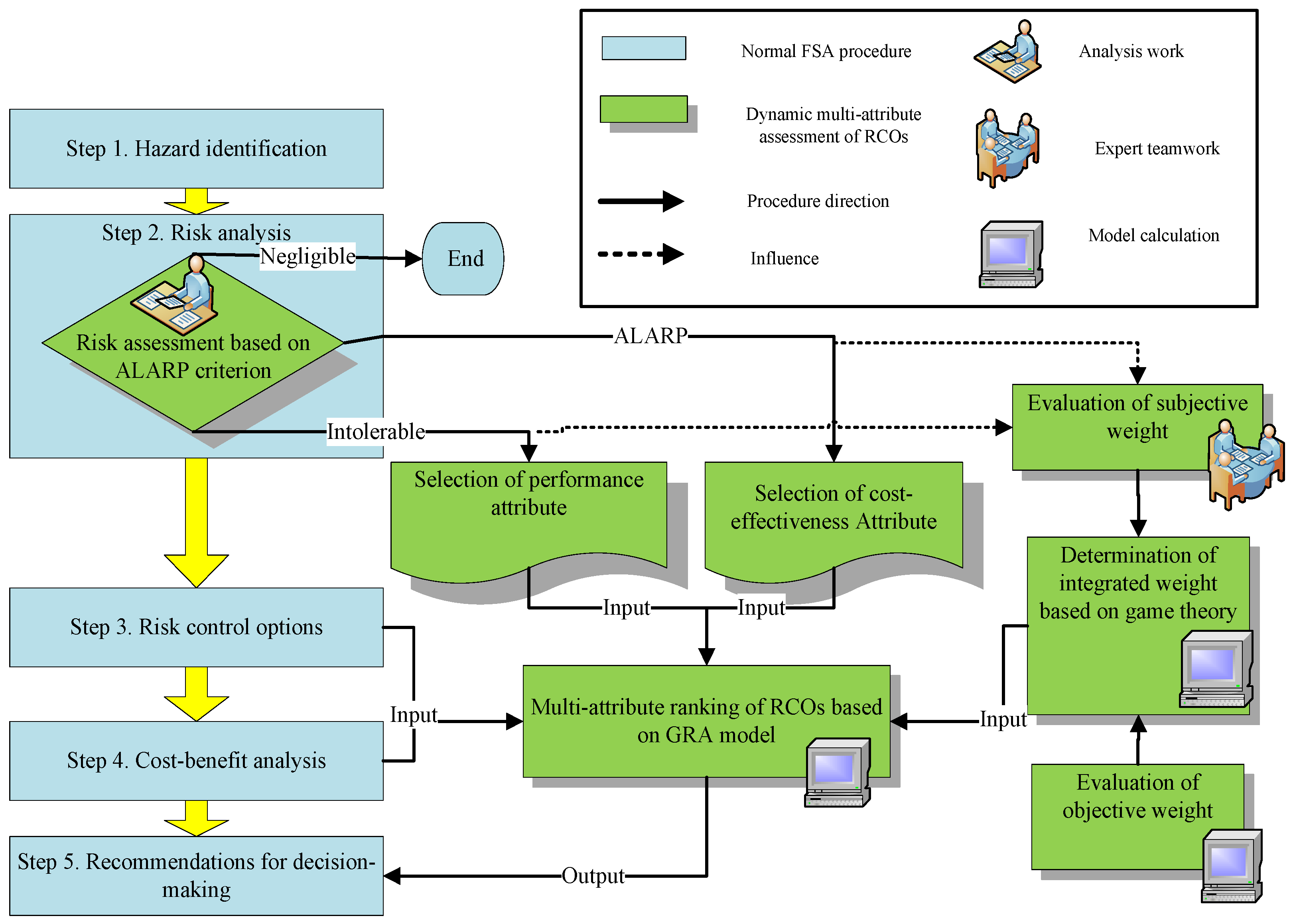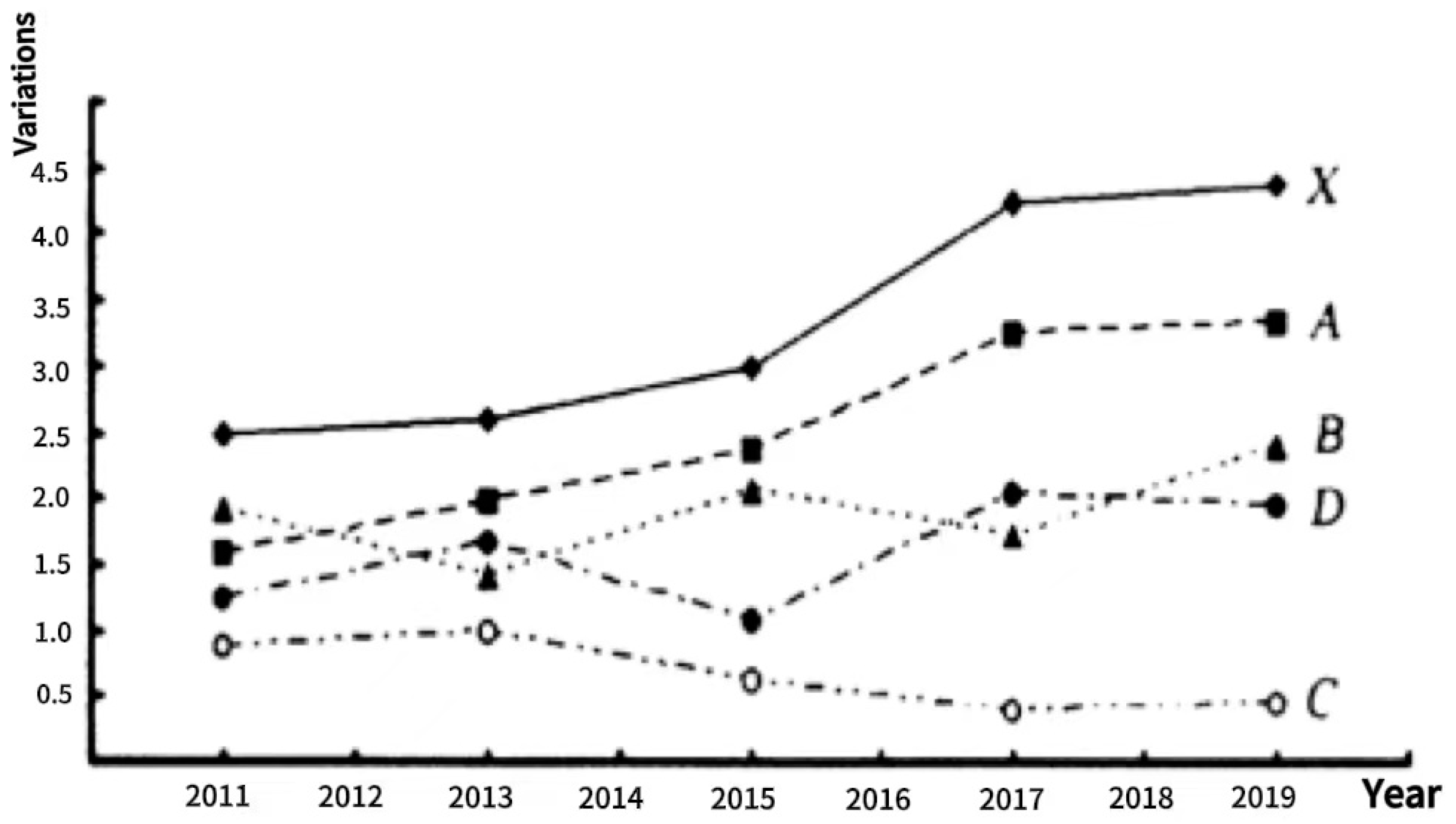Dynamic Multi-Attribute Decision-Making Method for Risk-Based Ship Design
Abstract
:1. Introduction
2. A Dynamic Multi-Attribute System for RCO Ranking
2.1. FSA and the ALARP Principle
2.2. Dynamic Multiple-Attribute Indices System
3. GRA Model for RCO Ranking
3.1. Model Definition
3.2. Linear Normalization of Attribute Sequences
3.3. Calculation of Grey Rational Coefficients
3.4. Calculation of GRD
4. Determination of Attribute Weights
4.1. Subjective Weight
4.2. Objective Weight
4.3. Integrated Weight
5. Example Application
5.1. Case Background
5.2. Traditional FSA
5.3. GRA for ALARP Risk Levels
5.3.1. Selection of Multi-Attribute Indices
5.3.2. Linear Normalization of the Attribute Sequences
5.3.3. Grey Rational Coefficient Matrix
5.3.4. Integrated Weight
5.3.5. GRD Calculation
5.4. GRA for Intolerable Risk Levels
5.5. GRA-Based RCO Ranking
5.6. Analysis of Results
6. Conclusions
Author Contributions
Funding
Institutional Review Board Statement
Informed Consent Statement
Data Availability Statement
Acknowledgments
Conflicts of Interest
References
- Wang, J. Offshore safety case approach and formal safety assessment of ships. J. Saf. Res. 2002, 33, 81–115. [Google Scholar] [CrossRef] [PubMed]
- Banda, O.A.V.; Goerlandt, F.; Kuzmin, V.; Kujala, P.; Montewka, J. Risk management model of winter navigation operations. Mar. Pollut. Bull. 2016, 108, 242–262. [Google Scholar] [CrossRef] [PubMed]
- Wang, Y.L.; Cha, Z.Q.; Liang, G.P.; Zhang, X.; Li, K.; Guan, G. Risk assessment of lng bunkering vessel operation based on formal safety assessment method. Process Saf. Prog. 2023, 2024, 299–312. [Google Scholar] [CrossRef]
- Siljung, Y.; Byongug, J.; Won-Ju, L. Improved formal safety assessment methodology using fuzzy topsis for lpg-fueled marine engine system. Ocean. Eng. 2023, 269, 113536. [Google Scholar]
- Meriam, C.; Ahmad, B.; Sunil, B.; Banda, O.A.; Floris, G. Towards system-theoretic risk assessment for future ships: A framework for selecting risk control options. Ocean. Eng. 2022, 259, 111797. [Google Scholar]
- Bao, J.Z.; Liu, Z.J.; Wang, L.D. Selection model of risk control option based on dominance degree. J. Traffic Transp. Eng. 2011, 11, 82–87. [Google Scholar]
- Jingxia, L.; Wang, L.; Bao, J. The application of grey relational projection to rank and optimize risk control options. In Proceedings of the 2015 12th International Conference on Fuzzy Systems and Knowledge Discovery (FSKD), Zhangjiajie, China, 15–17 August 2015; pp. 1676–1680. [Google Scholar]
- Puisa, R.; Vassalos, D. Robust analysis of cost-effectiveness in formal safety assessment. J. Mar. Sci. Technol. 2012, 17, 370–381. [Google Scholar] [CrossRef]
- Montewka, J.; Goerlandt, F.; Kujala, P. On a systematic perspective on risk for formal safety assessment (fsa). Reliab. Eng. Syst. Saf. 2014, 127, 77–85. [Google Scholar] [CrossRef]
- Haddad, R.K.; Harun, Z. Development of a novel quantitative risk assessment tool for UK road tunnels. Fire 2023, 6, 65. [Google Scholar] [CrossRef]
- Maselli, G.; Macchiaroli, M.; Nesticò, A. Alarp criteria to estimate acceptability and tolerability thresholds of the investment risk. Appl. Sci. 2021, 11, 9086. [Google Scholar] [CrossRef]
- Jiang, Z.; Zhao, T.; Wang, S.; Ren, F. A novel risk assessment and analysis method for correlation in a complex system based on multi-dimensional theory. Appl. Sci. 2020, 10, 3007. [Google Scholar] [CrossRef]
- Baybutt, P. The alarp principle in process safety. Process Saf. Prog. 2014, 33, 36–40. [Google Scholar] [CrossRef]
- Ge, W.; Li, Z.; Liang, R.Y.; Li, W.; Cai, Y. Methodology for establishing risk criteria for dams in developing countries, case study of China. Water Resour. Manag. 2017, 31, 4063–4074. [Google Scholar] [CrossRef]
- De Luque-Villa, M.A.; Robledo-Buitrago, D.A.; Gómez-Rendón, C.P. Holistic environmental risk index for oil and gas industry in Colombia. Sustainability 2024, 16, 2361. [Google Scholar] [CrossRef]
- Ilczuk, P.; Kycko, M. Risk assessment in the design of railroad control command and signaling devices using fuzzy sets. Appl. Sci. 2023, 13, 12460. [Google Scholar] [CrossRef]
- Sunil, B.; Ahmad, B.; Jakub, M.; Meriam, C.; Banda, O.A. Selecting cost-effective risk control option for advanced maritime operations; integration of stpa-bn-influence diagram. Ocean. Eng. 2023, 280, 114631. [Google Scholar]
- Ventikos, N.P.; Panagiotis, S.; Manolis, A.C.P.V.; Evangelos, B.; Fotios, S.; Stefanos, C.; Alessandro, M. The development and demonstration of an enhanced risk model for the evacuation process of large passenger vessels. J. Mar. Sci. Eng. 2023, 11, 84. [Google Scholar] [CrossRef]
- Deng, J.L. Grey group decision in grey rationale space. Sci. Technol. Inf. Serv. 1989, 1, 1–24. [Google Scholar]
- Feng, S.S.; Chen, Z.J.; Guan, Q.S.; Yue, J.T.; Xia, C.Y. Grey relational analysis-based fault prediction for watercraft equipment. Front. Phys. 2022, 10, 885768. [Google Scholar] [CrossRef]
- Grdinic-Rakonjac, M.; Antic, B.; Pesic, D.; Pajkovic, V. Construction of road safety composite indicator using grey relational analysis. Promet-Traffic Transp. 2021, 33, 103–116. [Google Scholar] [CrossRef]
- Dey, P.P.; Pramanik, S.; Giri, B.C. An extended grey relational analysis based multiple attribute decision making in interval neutrosophic uncertain linguistic setting. Neutrosophic Sets Syst. 2016, 11, 21–30. [Google Scholar]
- Ramesh, S.; Viswanathan, R.; Ambika, S. Measurement and optimization of surface roughness and tool wear via grey relational analysis, topsis and rsa techniques. Measurement 2016, 78, 63–72. [Google Scholar] [CrossRef]
- Zhou, J.; Ren, J.; Yao, C. Multi-objective optimization of multi-axis ball-end milling inconel 718 via grey relational analysis coupled with rbf neural network and pso algorithm. Measurement 2017, 102, 271–285. [Google Scholar] [CrossRef]
- Li, X.; Tang, W. A multiple attribute decision-making model of ship risk control options based on gray correlation. Shipbuild. China 2015, 56, 193–200. [Google Scholar]
- Deng, Z.; Du, A.; Yang, C.; Tong, J.; Chen, Y. Multilevel evaluation model of electric power steering system based on improved combination weighting and cloud theory. Appl. Sci. 2024, 14, 1043. [Google Scholar] [CrossRef]
- Arden, B. A bonneville power administration delphi0 project for power system operation and control. IEEE Trans. Power Appar. Syst. 1983, PAS-102, 2104–2109. [Google Scholar]
- Chen, J.; Gao, C.; Zhou, H.; Wang, Q.; She, L.; Qing, D.; Cao, C. Urban flood risk assessment based on a combination of subjective and objective multi-weight methods. Appl. Sci. 2024, 14, 3694. [Google Scholar] [CrossRef]
- Wang, X.; Zhang, L. A combined weighting model based on maximizing deviation for multiple attribute decision-making. Adv. Mater. Sci. Eng. 2022, 2022, 7679851. [Google Scholar] [CrossRef]
- Nafei, A.; Huang, C.Y.; Azizi, S.P.; Chen, S.C. An optimized method for solving membership-based neutrosophic linear programming problems. Stud. Inform. Control. 2022, 31, 45–52. [Google Scholar] [CrossRef]
- Mojtaba, B.; Sham, R.A.; Ahmad, E.S. A linearization to the multi-objective linear plus linear fractional program. Oper. Res. Forum 2023, 4, 82. [Google Scholar] [CrossRef]
- Yang, W.; Zhao, Z.; Wang, X.; Hu, S. The large deviation results for the nonlinear regression model with dependent errors. TEST 2017, 26, 261–283. [Google Scholar] [CrossRef]
- Lin, K.; Li, B. A cloud- and game model-based approach to project evaluations of sustainable power supply investments. Sustainability 2024, 16, 4040. [Google Scholar] [CrossRef]
- Vanem, E. Ethics and fundamental principles of risk acceptance criteria. Saf. Sci. 2012, 50, 958–967. [Google Scholar] [CrossRef]
- Liwang, H.; Ringsberg, J.W.; Norsell, M. Quantitative risk analysis—ship security analysis for effective risk control options. Saf. Sci. 2013, 58, 98–112. [Google Scholar] [CrossRef]
- Vanem, E.; Endresen, O.; Skjong, R. Cost-effectiveness criteria for marine oil spill preventive measures. Reliab. Eng. Syst. Saf. 2008, 93, 1354–1368. [Google Scholar] [CrossRef]
- Lai, C.; Chen, X.; Chen, X.; Wang, Z.; Wu, X.; Zhao, S. A fuzzy comprehensive evaluation model for flood risk based on the combination weight of game theory. Nat. Hazards 2015, 77, 1243–1259. [Google Scholar] [CrossRef]





| RCO | Accident Risks |
|---|---|
| RCO1 | Active steering gear redundancy |
| RCO2 | Electronic chart display and information |
| RCO3 | Terminal proximity and speed sensors |
| RCO4 | Navigational sonar |
| RCO5 | Better implementation of hot work |
| RCO6 | Double-walled hot fuel lines in the engine |
| RCO7 | Engine control room additional emergency |
| RCO8 | Hull stress and fatigue monitoring system |
| Performance Attribute | Cost-Effectiveness Attribute | |||||
|---|---|---|---|---|---|---|
| △PLL (Fatalities) | △PLO (Tons of Oil Spill) | △PLP (106 USD) | GCAF (106 USD) | NCAF (108 USD) | CATS (102 USD) | |
| RCO1 | 0.00012 | 16 | 0.53 | 40 | −43.8 | 3 |
| RCO2 | 0.0012 | 170 | 5.67 | 62.5 | −46.6 | 4.4 |
| RCO3 | - | 4 | 0.119 | - | - | 215 |
| RCO4 | 0.00049 | 70 | 2.36 | 401 | −44.2 | 28 |
| RCO5 | 0.019 | 45 | 2.2 | 1.45 | −1.11 | 4.5 |
| RCO6 | 0.014 | 154 | 5.3 | 2.7 | −3.71 | 2.5 |
| RCO7 | 0.0044 | - | - | 3.17 | 0.0317 | - |
| RCO8 | 0.00053 | 4 | 0.134 | 241 | −0.102 | 320 |
| GCAF | Ranking | |
|---|---|---|
| RCO1 | 40 | 4 |
| RCO2 | 62.5 | 5 |
| RCO3 | 401 | 8 |
| RCO4 | 401 | 7 |
| RCO5 | 1.45 | 1 |
| RCO6 | 2.7 | 2 |
| RCO7 | 3.17 | 3 |
| RCO8 | 241 | 6 |
| ALARP Risk Level | Intolerable Risk Level | |||||
|---|---|---|---|---|---|---|
| GCAF | NCAF | CATS | ||||
| (E1) | 0.47 | 0.12 | 0.41 | 0.73 | 0.19 | 0.08 |
| (E2) | 0.32 | 0.37 | 0.31 | 0.56 | 0.25 | 0.19 |
| (E3) | 0.13 | 0.62 | 0.25 | 0.43 | 0.12 | 0.45 |
| 0.31 | 0.37 | 0.32 | 0.57 | 0.19 | 0.24 | |
| 0.27 | 0.44 | 0.29 | 0.31 | 0.34 | 0.35 | |
| 0.28 | 0.42 | 0.30 | 0.54 | 0.21 | 0.25 | |
| ALARP Risk Level | Intolerable Risk Level | |||
|---|---|---|---|---|
| GRD | Ranking | GRD | Ranking | |
| RCO1 | 0.742 | 2 | 0.341 | 6 |
| RCO2 | 0.676 | 3 | 0.647 | 3 |
| RCO3 | 0.334 | 8 | 0.333 | 8 |
| RCO4 | 0.619 | 5 | 0.392 | 4 |
| RCO5 | 0.658 | 4 | 0.735 | 2 |
| RCO6 | 0.994 | 1 | 0.750 | 1 |
| RCO7 | 0.456 | 6 | 0.365 | 5 |
| RCO8 | 0.453 | 7 | 0.336 | 7 |
| Attribute Indices | Results of RCO Ranking |
|---|---|
| (GCAF, NCAF, CATS) | 6 > 1 > 2 > 5 > 4 > 7 > 8 > 3 |
| (△PLL, △PLO, △PLP) | 6 > 5 > 2 > 4 > 7 > 1 > 8 > 3 |
| GCAF | 5 > 6 > 7 > 1> 2 > 8 > 4 > 3 |
Disclaimer/Publisher’s Note: The statements, opinions and data contained in all publications are solely those of the individual author(s) and contributor(s) and not of MDPI and/or the editor(s). MDPI and/or the editor(s) disclaim responsibility for any injury to people or property resulting from any ideas, methods, instructions or products referred to in the content. |
© 2024 by the authors. Licensee MDPI, Basel, Switzerland. This article is an open access article distributed under the terms and conditions of the Creative Commons Attribution (CC BY) license (https://creativecommons.org/licenses/by/4.0/).
Share and Cite
Li, X.; Zhang, X.; Yuan, Y. Dynamic Multi-Attribute Decision-Making Method for Risk-Based Ship Design. Appl. Sci. 2024, 14, 5387. https://doi.org/10.3390/app14135387
Li X, Zhang X, Yuan Y. Dynamic Multi-Attribute Decision-Making Method for Risk-Based Ship Design. Applied Sciences. 2024; 14(13):5387. https://doi.org/10.3390/app14135387
Chicago/Turabian StyleLi, Xiaodong, Xueqian Zhang, and Yuchao Yuan. 2024. "Dynamic Multi-Attribute Decision-Making Method for Risk-Based Ship Design" Applied Sciences 14, no. 13: 5387. https://doi.org/10.3390/app14135387




